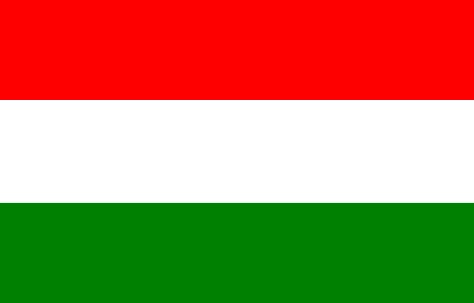|
Wednesday
26 November 2003
We
take the 10:01 train from Rotterdam Centraal to Amsterdam/Schiphol Airport. 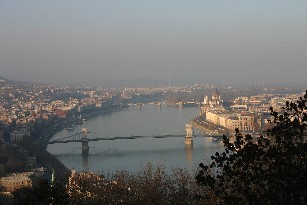 Checking in at Schiphol takes some time because of the security measures. We
take off for Budapest at 1.15pm with KLM. We arrive there around 3.00pm.
Checking in at Schiphol takes some time because of the security measures. We
take off for Budapest at 1.15pm with KLM. We arrive there around 3.00pm.
We
call a taxi from a reliable company (Fötaxi) on our mobile. The airport taxis
are in the hands of the local mafia and are after unsuspecting tourists whom the
charge 3 times the going rate. An alternative would have been the Mini
Bus, but with two persons that would not have been cheaper, only slower and less
reliable. Fötaxi arrives within 5 minutes from a parking lot just outside the
airport. The ride takes just over 30 minutes to central Budapest and sets
us back around 4000 Hungarian Forints (HUF) or €16. We arrive around 4.30 at Connection
Guesthouse. It is a gay guesthouse, where we will spend the next 5
nights.
After
having checked into our room we hit the town. We have some coffee and cake in a
tiny café, called Aztek Xocolat. Later that night we eat at Club 93. A " gay"
pizzeria. A small affair, with friendly staff and reasonable pizzas at a
bargain price (HUF 1000 = €4).
Later
in the evening we visit 2 gay pubs before we return to the guest house.
It
was a gray day today in
Budapest with an occasional drizzle.
Donderdag
27 November 2003
We start the day with
an excellent breakfast. We are the only guests today and the guy at reception is
extremely helpful .
After that we walk into town. We have coffee with cake at Gerbaud. This
sort of an institution in Budapest. A classic, with a wide range of fine cakes
and delicious flavours of coffee. A sight in its own right. .
After that we walk into town. We have coffee with cake at Gerbaud. This
sort of an institution in Budapest. A classic, with a wide range of fine cakes
and delicious flavours of coffee. A sight in its own right.
At Déak Tér
subway station we buy a 7-day Travel Card for HUF 2250 (Wochenticket or Hetijegy),
allowing one week of travel on all lines (metro, bus, tram, trolley bus) of BKV,
the public transport authority of Budapest. Budapest has the oldest underground
of continental Europe. We take bus #16 to the Castle Hill of Buda. It takes us
across the Chain Bridge to Buda. Line #16 ends at Disz Tér (Note:. Tér=square)
in the middle of the Castle. We walk through the castle. We take a look in the
old Eagle Pharmacy. It is a museum now with a period furnishing. We are
guided around by Ms Eva  Holland (!)
She tells lots and lots about the items on display. There is even a mummified
head. This was used in the 18th century to make mummy powder, which was used to
treat epilepsy and other ailments. We continue to the nearby Matyas church.
A beautiful 19th century neo-baroque church. It is a replacement of earlier
churches that stood here but were destroyed. To this spot came the Hungarian
Kings before they would be crowned elsewhere in Hungary. The church has fine
chapels and frescoes. There is also a museum in which a replica of the Royal
regalia are on display - among which the St Stephan's crown. Next door to the
church is the Fisherman Bastion Holland (!)
She tells lots and lots about the items on display. There is even a mummified
head. This was used in the 18th century to make mummy powder, which was used to
treat epilepsy and other ailments. We continue to the nearby Matyas church.
A beautiful 19th century neo-baroque church. It is a replacement of earlier
churches that stood here but were destroyed. To this spot came the Hungarian
Kings before they would be crowned elsewhere in Hungary. The church has fine
chapels and frescoes. There is also a museum in which a replica of the Royal
regalia are on display - among which the St Stephan's crown. Next door to the
church is the Fisherman Bastion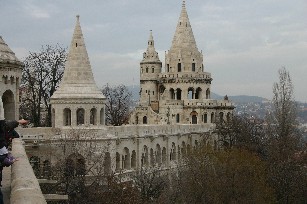 .
This has never served as a defence line, but is purely decorative. It does,
however, frame a beautiful view of Pest on the other side of the Danube. It is
busy with tourists and buskers and people trying to sell all kinds of well meant
or not so well meant paraphernalia. We continue through the old town of Buda and
take a look at the monumental buildings belonging to the National
Archives. .
This has never served as a defence line, but is purely decorative. It does,
however, frame a beautiful view of Pest on the other side of the Danube. It is
busy with tourists and buskers and people trying to sell all kinds of well meant
or not so well meant paraphernalia. We continue through the old town of Buda and
take a look at the monumental buildings belonging to the National
Archives.
We
eat a simple and overpriced meal at the Sissi restaurant, named after the former
empress and queen of Austria and Hungary respectively. Sissi, or Elisabeth (Erzébet
in Hungarian) was very popular with the Hungarians because of her interest in
the Hungarian language and culture. This in contrast to her husband emperor Franz-Josef.
We
take the cable car down hill. There we jump on tram #41 and then change to bus
#27 to the top of the St Gellért Hill. At its peak is the citadel -
built by the Austrians after the rebellion of 1849 to keep the Hungarians in
check - and the freedom monument. This monument is the statue of a woman
holding an olive branch. The monument was at one stage adorned with statues of
Russian soldiers, who liberated the country of the Germans, but they have been
removed in 1990 and now stand in the Statue Park outside of town.
The
view from Gellert Hill on the city (both Buda and Pest) is unmatched. We take
bus and tram back to our guest house.
Late
afternoon we take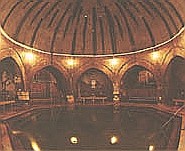 the metro to the Kiraly-baths. This is an old Turkish
complex of thermal baths. This history of these baths goes back to 1565. It was
built so that the city would have a bath within the walls in case of a siege.
Its present name Kiraly (=King) is owed the the König family who owned the bath
from 1796. We buy a ticket for the bath. Only
having to surrender it within seconds to an attendant. He sends us upstairs with
a numbered piece of paper. Upstairs we find the changing cabins. We hand in our
number to another attendant who points us to our cabins. After undressing we
lock the cabin wit a key, after which the attendant locks a second lock and
scribbles something illegible on a slate. We go downstairs and get into
the the large thermal pool under an Ottoman dome. The pool is full of men
(men's days are Tuesday, Thursday and Saturday; women on Monday, Wednesday and
Friday). Although the signs clearly state that bathing suits are compulsory
everybody is naked. Next to the pool are a steam room, cold baths and dry
saunas. More than 80% of the crowd is gay and the mood is fairly cruisy
[Nothing really improper happens at all, but there are a few rent boys about
trying to solicit business].
Erik takes a massage, (buy a ticket at the entrance), but that is a big
disappointment. After 90 minutes our time is up. We get dressed again in our
cabins and leave the baths relaxed and satisfied.
the metro to the Kiraly-baths. This is an old Turkish
complex of thermal baths. This history of these baths goes back to 1565. It was
built so that the city would have a bath within the walls in case of a siege.
Its present name Kiraly (=King) is owed the the König family who owned the bath
from 1796. We buy a ticket for the bath. Only
having to surrender it within seconds to an attendant. He sends us upstairs with
a numbered piece of paper. Upstairs we find the changing cabins. We hand in our
number to another attendant who points us to our cabins. After undressing we
lock the cabin wit a key, after which the attendant locks a second lock and
scribbles something illegible on a slate. We go downstairs and get into
the the large thermal pool under an Ottoman dome. The pool is full of men
(men's days are Tuesday, Thursday and Saturday; women on Monday, Wednesday and
Friday). Although the signs clearly state that bathing suits are compulsory
everybody is naked. Next to the pool are a steam room, cold baths and dry
saunas. More than 80% of the crowd is gay and the mood is fairly cruisy
[Nothing really improper happens at all, but there are a few rent boys about
trying to solicit business].
Erik takes a massage, (buy a ticket at the entrance), but that is a big
disappointment. After 90 minutes our time is up. We get dressed again in our
cabins and leave the baths relaxed and satisfied.
At
night we have a simple and ridiculously cheap meal at an Hungarian restaurant
called
Kiskakacs near our guest house. Later we explore the gay scene a bit further. We
visit the Amstel River Café, a "Dutch style" gay
friendly pub and later the Action Bar, a crowded, but friendly leather bar. We
take a taxi back, because the trams stop running after 11.15pm!! It is
best to call for a taxi on your mobile, as it is cheaper than hailing one on the
street. And you are sure that you have a reliable one and not some sort of a
mobster. We call again for Fötaxi and get picked up within minutes.
Today
was dry and sunny with temperatures around 14°C/40°F.
Friday
28
November 2003
We
drink coffee again at Gerbaud on Vörósmarty Tér. The stall for the Christmas
market are being set up this morning. After coffee we go for a walk through the Lipótváros
district. We start at Roosevelt Tér near the Chain Bridge 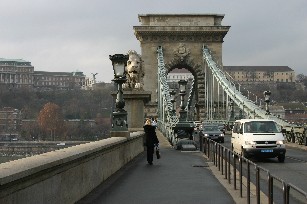 across
the Danube. The Chain Bridge is the oldest fixed link between Buda and Pest,
replacing seasonal ferries. The bridge was completed in 1849. In 1945 it was
destroyed by the Germans, but reopened a century after its first opening. At Roosevelt Tér
is the Gresham Palace. An Art Nouveau building, that is currently being
converted into a luxury hotel. It was once commissioned by an insurance company.
It its facade we see the head of Sir Thomas Gresham (1519?–1579), an English financier,
who first formulated Gresham's Law stating that bad money works out good money.
The square is flanked by two statues of Hungarian leaders: Count Szechenyi and Ferenc
Déak. On the North side of the square is the Hungarian Academy of
Sciences. We continue towards the St Stephan's basilica, named
after the first Christian king of Hungary. Construction of the church started in
1851, but w across
the Danube. The Chain Bridge is the oldest fixed link between Buda and Pest,
replacing seasonal ferries. The bridge was completed in 1849. In 1945 it was
destroyed by the Germans, but reopened a century after its first opening. At Roosevelt Tér
is the Gresham Palace. An Art Nouveau building, that is currently being
converted into a luxury hotel. It was once commissioned by an insurance company.
It its facade we see the head of Sir Thomas Gresham (1519?–1579), an English financier,
who first formulated Gresham's Law stating that bad money works out good money.
The square is flanked by two statues of Hungarian leaders: Count Szechenyi and Ferenc
Déak. On the North side of the square is the Hungarian Academy of
Sciences. We continue towards the St Stephan's basilica, named
after the first Christian king of Hungary. Construction of the church started in
1851, but w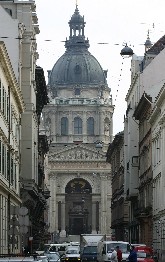 as
not completed until 1905. The church is built in a neo baroque style, with
lots of detail. In a separate chapel the holiest Hungarian relic is being kept
in a gold plated shrine. It is the mummified right hand of King Stephan (István)
himself. Stephan was the first king of Hungary who converted to Christianity and
was crowned with the pope's blessing in the year 1000. Stephan descends from
Arpád who led the Magyar tribes in 896 (an important number in Hungary) to
settle in the Carpathians. The hand is carried around the city every year
on August 15th the anniversary of Stephan's death. The dome of the church is 96
metres high, the same height as the parliament. It's height refers to the year
896. After the visit of the magnificent church we walk on to the Liberty Square
(Szabadzág ter). This square is flanked by beautiful buildings. To the left we
see the former stock exchange of Hungary. A neo-classical building, with two
towers resembling Khmer temples. After the Communists take-over in 1948 the
exchange was closed and the building became the headquarters for Hungarian Radio
and Television. On the opposite side is the building of the Hungarian National
Bank. During the course of history various regimes have added and removed
their contributions to the square. Once there was here a monument to the
Hungarian Sorrow, commemorating the Treaty of Trianon of 1919, in which Hungary
lost two thirds of its territory and one third of its Hungarian speaking
population (to Czechoslovakia, Romania and Yugoslavia). This monument was
replaced in 1948 by one for the Soviet liberators. In 1990 there were calls for
replacing it again by the Sorrow monument, but this did not happen. In 1989 a
monument for an American general was brought back in on the occasion of a visit
by US president Bus as
not completed until 1905. The church is built in a neo baroque style, with
lots of detail. In a separate chapel the holiest Hungarian relic is being kept
in a gold plated shrine. It is the mummified right hand of King Stephan (István)
himself. Stephan was the first king of Hungary who converted to Christianity and
was crowned with the pope's blessing in the year 1000. Stephan descends from
Arpád who led the Magyar tribes in 896 (an important number in Hungary) to
settle in the Carpathians. The hand is carried around the city every year
on August 15th the anniversary of Stephan's death. The dome of the church is 96
metres high, the same height as the parliament. It's height refers to the year
896. After the visit of the magnificent church we walk on to the Liberty Square
(Szabadzág ter). This square is flanked by beautiful buildings. To the left we
see the former stock exchange of Hungary. A neo-classical building, with two
towers resembling Khmer temples. After the Communists take-over in 1948 the
exchange was closed and the building became the headquarters for Hungarian Radio
and Television. On the opposite side is the building of the Hungarian National
Bank. During the course of history various regimes have added and removed
their contributions to the square. Once there was here a monument to the
Hungarian Sorrow, commemorating the Treaty of Trianon of 1919, in which Hungary
lost two thirds of its territory and one third of its Hungarian speaking
population (to Czechoslovakia, Romania and Yugoslavia). This monument was
replaced in 1948 by one for the Soviet liberators. In 1990 there were calls for
replacing it again by the Sorrow monument, but this did not happen. In 1989 a
monument for an American general was brought back in on the occasion of a visit
by US president Bus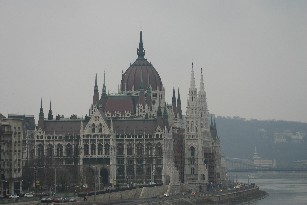 h
sr. The general had single handedly prevented Romanian troops from looting the
Ethnological Museum in 1919. Opposite the Soviet monument is ironically
enough the residence of the US embassy. Behind the embassy we find the the head
office of the post office savings bank. It is an Art Nouveau building with a
very fanciful roof. The architect held the opinion that even birds were entitled
to good architecture. The facade is painted with swarms of bees (representing
the savings) swarming towards the roof. Opposite the bank office we discover a
market hall - one several market halls in Budapest. It is a good place for
buying meat, fish, vegetables and fruit. h
sr. The general had single handedly prevented Romanian troops from looting the
Ethnological Museum in 1919. Opposite the Soviet monument is ironically
enough the residence of the US embassy. Behind the embassy we find the the head
office of the post office savings bank. It is an Art Nouveau building with a
very fanciful roof. The architect held the opinion that even birds were entitled
to good architecture. The facade is painted with swarms of bees (representing
the savings) swarming towards the roof. Opposite the bank office we discover a
market hall - one several market halls in Budapest. It is a good place for
buying meat, fish, vegetables and fruit.
A
few minutes from here we reach the
Parliament.
English tours are conducted at 10am, noon en 2pm. We buy a ticket at entrance X.
You can not just walk up there. A guard has to let you onto the premises. It is
not cheap (HUF 2000 or €8 pp), but well worth it.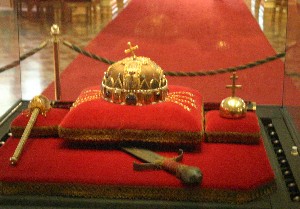 The building is a fine neo-classical construction with lots of plated gold and
symbolism. It was completed in 1904. At the entrance our attention is drawn by a
scale model of the building. It was made entire out of match sticks by a
patriotic Hungarian family. The family was rewarded with a brand new apartment
by the government. Under the central dome we see statues of Hungary's most
significant kings. In the middle is a show case with the original royal regalia
of Hungary: the St Stephan's crown, the scepter and a gold plated orb. At
the end of the tour we peek inside the assembly room. In its time (1904) it was
one of the most modern in Europe. It had central heating and an air conditioning
system that worked on large blocks of ice. This was replaced by modern equipment
only in 1999. The parliament was also fitted with electric lights (it consumed
more power than the rest of the city in those days) and elevators. Quaint
detail are the cigar holders in the lobby. Members were not allowed to smoke in
the assembly. They could do that in the lobby. If they were called into the
assembly for a vote or a speech they would place their cigars in their personal
holder. If the speaker was very good it could happen that the cigar had gone by
the time the members returned. They used to say that the speaker had "been
worth a good Havana". .
The building is a fine neo-classical construction with lots of plated gold and
symbolism. It was completed in 1904. At the entrance our attention is drawn by a
scale model of the building. It was made entire out of match sticks by a
patriotic Hungarian family. The family was rewarded with a brand new apartment
by the government. Under the central dome we see statues of Hungary's most
significant kings. In the middle is a show case with the original royal regalia
of Hungary: the St Stephan's crown, the scepter and a gold plated orb. At
the end of the tour we peek inside the assembly room. In its time (1904) it was
one of the most modern in Europe. It had central heating and an air conditioning
system that worked on large blocks of ice. This was replaced by modern equipment
only in 1999. The parliament was also fitted with electric lights (it consumed
more power than the rest of the city in those days) and elevators. Quaint
detail are the cigar holders in the lobby. Members were not allowed to smoke in
the assembly. They could do that in the lobby. If they were called into the
assembly for a vote or a speech they would place their cigars in their personal
holder. If the speaker was very good it could happen that the cigar had gone by
the time the members returned. They used to say that the speaker had "been
worth a good Havana". .
After
the visit we have lunch. Then we take the metro towards Heroes Square
(Hösök
Tere). This large square was constructed in 1896 on the occasion of 1000 year jubilee
of the Hungarian Nation. In the middle is a column topped by the Arch Angel Gab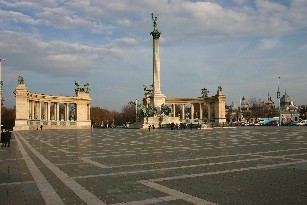 riel
that allegedly appeared in a dream of King Stephan, offering him the
Hungarian crown. At its base is are the figures of King Arpad and his
chieftains. He was the king who led the Magyars into the Carpathians. Behind all
that is a semicircular colonnade with statues of great men in Hungarian history.
Behind Hero square begins Vorosliget, the big park of the city. Directly
rigth is a lake that serves as one of Europes loveliest ice rinks in winter
(like now). It lies at the backdrop of the Vajdahunyad castle. A
catalogue in stone of all architectural styles through the centuries of
Hungarian history. It was put here in 1896. After a round through the park we
take the metro back down town for some shopping in the Vaci Ut, Budapest central
shopping street. We have a drink in the Amstel River cafe. riel
that allegedly appeared in a dream of King Stephan, offering him the
Hungarian crown. At its base is are the figures of King Arpad and his
chieftains. He was the king who led the Magyars into the Carpathians. Behind all
that is a semicircular colonnade with statues of great men in Hungarian history.
Behind Hero square begins Vorosliget, the big park of the city. Directly
rigth is a lake that serves as one of Europes loveliest ice rinks in winter
(like now). It lies at the backdrop of the Vajdahunyad castle. A
catalogue in stone of all architectural styles through the centuries of
Hungarian history. It was put here in 1896. After a round through the park we
take the metro back down town for some shopping in the Vaci Ut, Budapest central
shopping street. We have a drink in the Amstel River cafe.
At
nigh we have dinner at Kafé
Kör. Fine dining and excellent service.
After
dinner we have a drink in the
Mystery bar,
after which we head for the Uniform Party at Chaos Pub. But that is a bit of a
disappointment.
|
